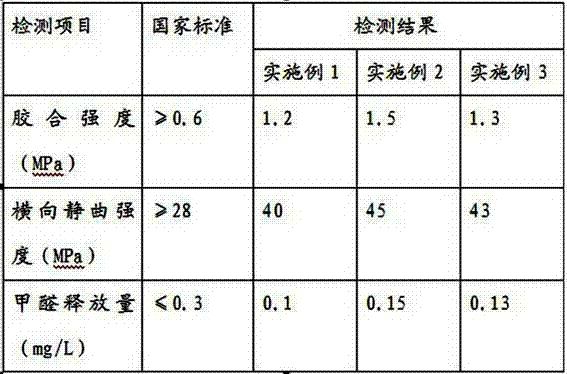Adhesive with ultralow formaldehyde release amount, and preparation method of same
A formaldehyde emission, adhesive technology, applied in adhesives, aldehyde/ketone condensation polymer adhesives, adhesive types, etc., can solve the problems of polluting the environment, damaging human health, high formaldehyde emission, etc., and achieve low free formaldehyde , easy operation and simple preparation process
- Summary
- Abstract
- Description
- Claims
- Application Information
AI Technical Summary
Problems solved by technology
Method used
Image
Examples
Embodiment 1
[0023] A. Add 1000 parts of formaldehyde into the reaction kettle, adjust the pH to 8.7 with 9.3 parts of sodium hydroxide, and add 1.7 parts of polyvinyl alcohol after 10 minutes to form solution A;
[0024] B. When the temperature rises to 30-35°C, add 377 parts of urea and 31.5 parts of melamine to solution A, raise the temperature to 89°C within 55 minutes, and keep the temperature at 88-92°C for 30 minutes to obtain solution B;
[0025] C. Slowly add 7 parts of formic acid to solution B, adjust the pH value to 6.0, and control the temperature at 88-92°C to react, when the viscosity reaches 19.8 seconds / 30°C as the end point, solution C is obtained;
[0026] D. Add 3 parts of triethanolamine to solution C, adjust the pH value to 7.3 with 5.2 parts of sodium hydroxide, add 166 parts of urea and 13.5 parts of melamine, and react at a temperature of 82-85°C for 30 minutes to obtain solution D;
[0027] E. Add 6.5 parts of sodium hydroxide to adjust the pH value of soluti...
Embodiment 2
[0030] A. Add 1000 parts of formaldehyde into the reaction kettle, adjust the pH to 8.5 with 9 parts of sodium hydroxide, and add 2.5 parts of polyvinyl alcohol after 10 minutes to form solution A;
[0031] B. When the temperature rises to 30-35°C, add 368 parts of urea and 26.6 parts of melamine to solution A, raise the temperature to 88°C within 45 minutes, and keep the temperature at 88-92°C for 30 minutes to obtain solution B;
[0032] C. Slowly add 6.2 parts of formic acid to solution B, adjust the pH value to 6.3, and control the temperature at 88-92°C to react, when the viscosity reaches 21 seconds / 30°C as the end point, solution C is obtained;
[0033] D. Add 2.1 parts of triethanolamine to solution C, adjust the pH value to 7.2 with 5.8 parts of sodium hydroxide, add 191 parts of urea and 11.4 parts of melamine, and react at 83-85°C for 30 minutes to obtain solution D;
[0034] E. Add 7.0 parts of sodium hydroxide to adjust the pH value of solution D to 7.35, add...
Embodiment 3
[0037] A. Add 1000 parts of formaldehyde into the reaction kettle, adjust the pH to 8.7 with 9.8 parts of sodium hydroxide, and add 2.1 parts of polyvinyl alcohol after 10 minutes to form solution A;
[0038] B. When the temperature rises to 30-35°C, add 376 parts of urea and 28.7 parts of melamine to solution A, raise the temperature to 88-92°C within 30-60 minutes, and keep the temperature at 88-92°C for 30 minutes. Obtain solution B;
[0039] C. Slowly add 7.8 parts of formaldehyde to solution B, adjust the pH value to 5.8, and control the temperature at 88-90°C for reaction, when the viscosity reaches 20.3 seconds / 30°C as the end point, solution C is obtained;
[0040] D. Add 2.6 parts of triethanolamine to solution C, adjust the pH value to 7.4 with 5.7 parts of sodium hydroxide, add 190 parts of urea and 12.3 parts of melamine, and react at 80-85°C for 30 minutes to obtain solution D;
[0041] E. Add 7.3 parts of sodium hydroxide to adjust the pH value of solution ...
PUM
| Property | Measurement | Unit |
|---|---|---|
| Density | aaaaa | aaaaa |
Abstract
Description
Claims
Application Information
 Login to View More
Login to View More - R&D
- Intellectual Property
- Life Sciences
- Materials
- Tech Scout
- Unparalleled Data Quality
- Higher Quality Content
- 60% Fewer Hallucinations
Browse by: Latest US Patents, China's latest patents, Technical Efficacy Thesaurus, Application Domain, Technology Topic, Popular Technical Reports.
© 2025 PatSnap. All rights reserved.Legal|Privacy policy|Modern Slavery Act Transparency Statement|Sitemap|About US| Contact US: help@patsnap.com

